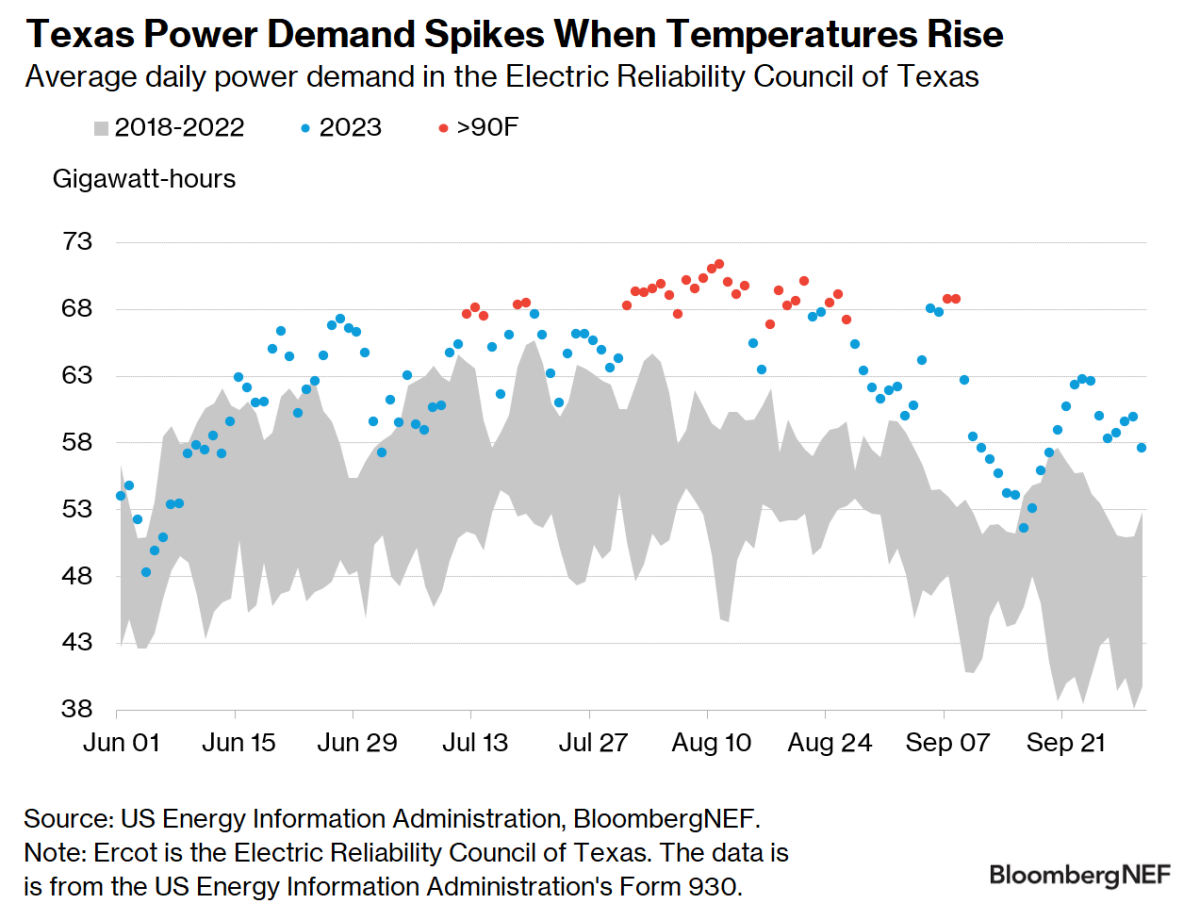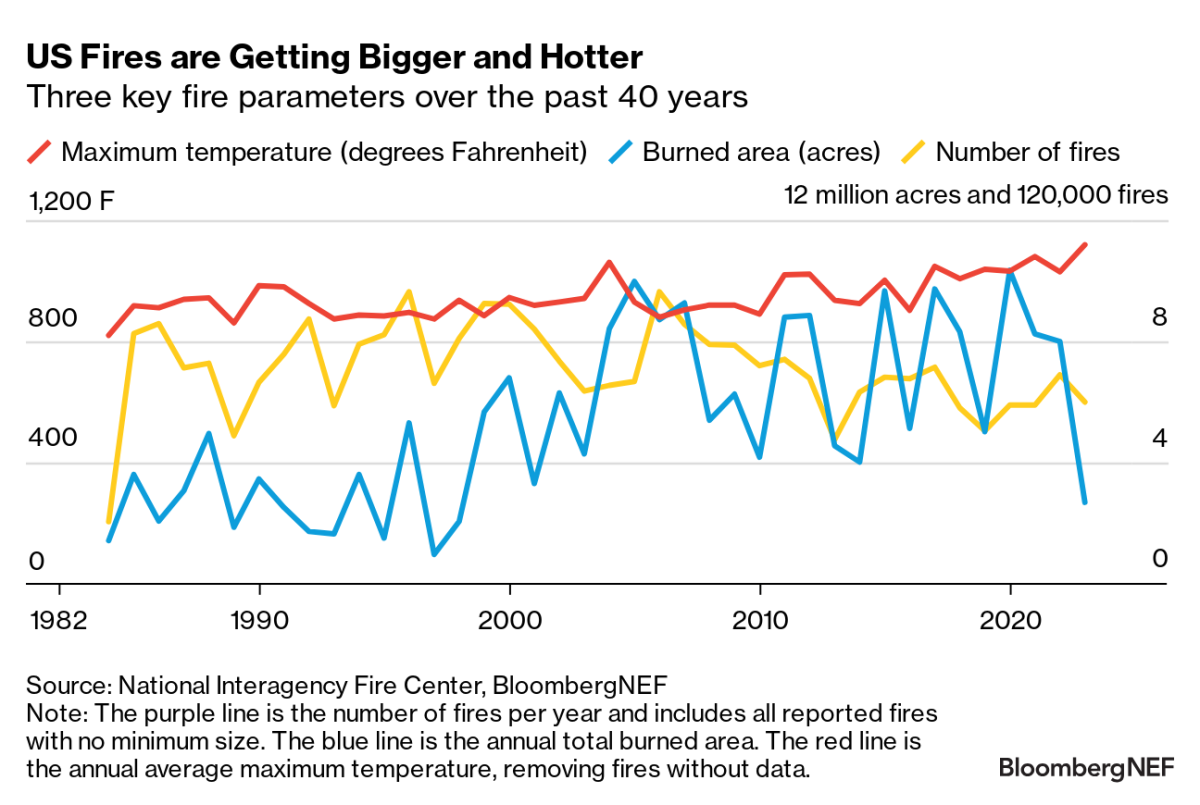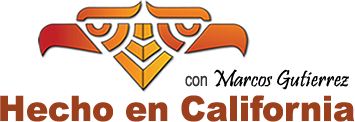El clima diario afecta las necesidades de calefacción y refrigeración. Los fenómenos meteorológicos extremos pueden alterar la infraestructura y provocar picos de demanda de energía. En resumen, los cambios en el clima pueden desequilibrar los mercados de materias primas, entorpecer las cadenas de suministro y distorsionar los precios de los productos energéticos, según un reciente informe de BloombergNEF.
Cinco de los impactos de estos patrones climáticos cambiantes ya se están manifestando hoy en los mercados de energía y materias primas.
1. Los inviernos son cada vez más cálidos, lo que lleva a una menor demanda de gas
Las temperaturas invernales en los Estados Unidos han aumentado un 2% en los últimos 10 años, en comparación con los niveles de 1990-1999. Esto reduce la demanda total de calefacción residencial y comercial, lo que lleva a mayores niveles de almacenamiento de gas natural y a precios más bajos. Un cambio de un grado Fahrenheit en las temperaturas invernales promedio puede reducir las extracciones anuales de gas en un 6% en promedio. A medida que los inviernos se vuelven más suaves, la necesidad de mayores inventarios de gas disminuye, lo que hace que las empresas de servicios públicos redefinan los volúmenes de almacenamiento y empuja a los productores de gas a recurrir a las exportaciones como fuente de ingresos.
2. Los veranos en Estados Unidos ya son calurosos y, a medida que se vuelven aún más calurosos, están estresando las redes eléctricas
Los grados-día anuales de enfriamiento (una medida de cuánto por encima de lo “cómodo”, o 65 grados Fahrenheit, está un día) han aumentado un 17% en comparación con el promedio de 1990-1999, y el verano de 2024 fue el más caluroso jamás registrado. El calor del verano es peligroso para las redes eléctricas: cuando la gente enciende sus aires acondicionados, la demanda de energía se dispara, estresando la red y aumentando el riesgo de apagones. Los combustibles fósiles entran entonces en acción para complementar la generación de energías renovables intermitentes, lo que hace que la transición energética dé un giro de 180 grados.

3. El noroeste se está volviendo más seco, lo que hace que la energía hidroeléctrica se marchite
Las precipitaciones de verano en el noroeste han disminuido un 26%, en comparación con el promedio de los últimos 10 años (2014-2023) en la década de 1990 (1990-1999). Obviamente, eso es un problema para la agricultura. También es un problema para el suministro de energía de la región, que está dominado por proyectos hidroeléctricos. Cuando la lluvia es escasa, los embalses hidroeléctricos dependen del deshielo de la nieve para mantener niveles robustos de agua. Pero la fracción de la precipitación invernal que cae en forma de nieve en la región está disminuyendo constantemente, disminuyendo a una tasa promedio de 0,6% por año desde 2000. Si esta tendencia continúa, la región podría ver una disminución en la generación de energía hidroeléctrica convencional, lo que impactaría los modelos de negocios de las empresas de servicios públicos y los productores de energía independientes.
4. Los incendios forestales se están expandiendo y amenazan a las viviendas y las infraestructuras
La superficie anual quemada por los incendios forestales en Estados Unidos se ha más que duplicado en comparación con el promedio de 1990-1999, a medida que las condiciones climáticas propicias para los incendios se vuelven más frecuentes y los incendios se hacen más grandes y más calientes. El oeste de Estados Unidos ha experimentado un aumento particularmente grande en los daños relacionados con los incendios forestales, y el suroeste agregó un mes adicional de días anuales de clima con riesgo de incendios en los últimos 50 años.
Las temperaturas de los incendios también están aumentando, a un ritmo de 3,7 grados Fahrenheit por año desde 1984. Eso está haciendo que los incendios sean más peligrosos para las personas y las infraestructuras. Las empresas de servicios públicos con líneas eléctricas en regiones propensas a incendios deberán tener en cuenta estos riesgos a medida que construyen sus redes y hacen planes para aumentar la resiliencia.

5. Las condiciones de los huracanes están empeorando, golpeando la infraestructura de petróleo y gas
Los huracanes del Atlántico Norte son los eventos climáticos extremos más costosos para los EE. UU., acumulando más de 1,3 billones de dólares en daños desde 1980. Los huracanes también plantean un tremendo riesgo para la producción de petróleo y gas en alta mar en el Golfo de México. La mayoría de las caídas de producción importantes en la región corresponden a eventos de huracanes importantes desde 1990. Hoy, más tormentas en la cuenca del Atlántico Norte están alcanzando la fuerza de un huracán importante y los científicos esperan que la intensidad de los huracanes aumente con el calentamiento global.

Como se espera que estos patrones climáticos persistan –e incluso se intensifiquen– en los próximos años, las partes interesadas, desde las instituciones financieras hasta los responsables de las políticas y las empresas de energía, deberán comenzar a tener en cuenta los riesgos mencionados en su planificación estratégica a largo plazo.




